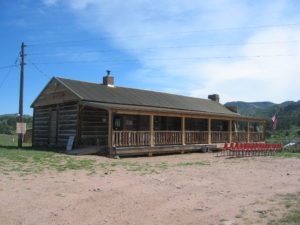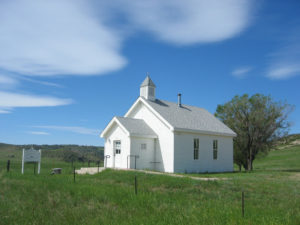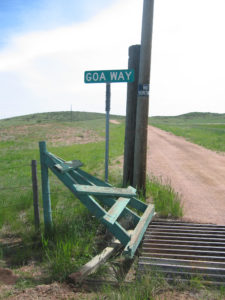Story
The first right after Goa Way: Exploring a stage station on the Overland Trail
On a lonely stretch of highway about 100 miles north of Denver, there’s a sign for a town where no town exists: Virginia Dale, Colorado. There’s a boarded-up post office, a tiny community church, and a Colorado historical site marker that may or may not catch your eye as you drive by on US Highway 287 at seventy-five miles an hour.
This is a rocky, rugged stretch of land, and there’s a sense of melancholy as you drive through. It’s like a ghost town where even the ghosts have up and gone. And it doesn’t help that, as you approach this hub of inactivity from the south, a local rancher has put up a fake street sign that says "GOA WAY."
This is why, every time I drove through here, I’d wonder: how did this area come to deserve a name? What was here? And who was Virginia?
My questions were answered earlier this summer, when the Virginia Dale Community Club held their annual open house and crafts show. As it turns out, the answers involve tales of murder, mischief, mayhem, and Mark Twain, during a time when the West was a lot wilder.
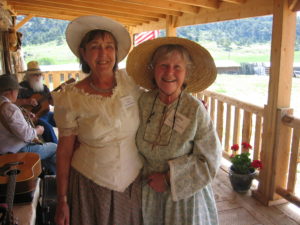
Members of the Virginia Dale Community Club host an open house and craft show fundraiser every year.
The story starts in 1862, when the Overland Trail Mail Route was moved to the Cherokee Trail, which later became known as the Overland Trail. From 1862 to 1869, this trail through Oklahoma, Kansas, Colorado, and Wyoming was the preferred and safest route for mail coaches and travelers to reach the Oregon Trail in Fort Bridger, Wyoming. Along this route were the Overland Trail Stage Stations. They were located every ten to fifteen miles or so along the trail, with larger “home stations” every fifty miles or so. These were places where drivers could change horses or mules and dusty travelers could get a modest meal and simple overnight lodging. On a given night, there might be fifty to 100 wagons camped at a home station.
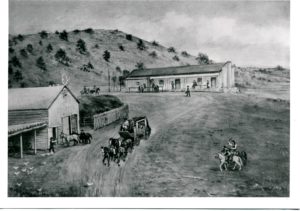
The Overland Stage Station as painted by William Henry Jackson in 1867.
One of these home stations, called the Overland Stage Station, was built in 1862 in a picturesque Colorado valley less than five miles from the Wyoming border. The man hired to oversee construction and management of the station was named Jack Slade. For a few years, Slade may have been one of the best-known men in the West. Kinder accounts of his character say that he was a dedicated, competent company man who turned into a mean drunk with a vicious temper. Other tales of Jack Slade, which may have been exaggerated over the years, involve twenty-six dead bodies, a multi-million-dollar stagecoach robbery, and a human ear that Jack wore on his watch chain.
Much of what has actually happened has been lost to history, but several stories are accepted as true. One is that Samuel Clemens (also known as Mark Twain) met Jack Slade and then wrote about him in the book Roughing It. Another is that the valley (or “dale”) where the station was built was named after Slade’s wife. We also know that, after a series of bad decisions, Slade lost his job, moved to Montana, drank heavily, and became a serious public nuisance. In 1864, after shooting off his mouth and his gun one too many times, he was lynched by vigilantes. His body was then preserved in alcohol and shipped by his wife to Salt Lake City, where his remains remain today.
Just a few years later, the First Transcontinental Railroad began to put stagecoaches out of business. In quiet Virginia Dale, the Overland Stage Station changed hands and uses several times, eventually being turned over to a community organization. In 1985 it was listed in the National Register of Historic Places. For a while, Highway 287 ran right through the dale, but the road was later moved to its current location about a mile to the west, leaving the Overland Stage Station to slowly deteriorate for decades.
In more recent years, under the direction of the Virginia Dale Community Club and several grants from the Colorado Historical Society (now known as History Colorado), the Overland Stage Station has been gradually renovated. Following a fundraising push that began in 2016, the 155-year-old building has new windows, a new roof, a new porch and railings, and several other improvements. Right now, it’s probably the best it's looked for more than a century. It’s the only stage station still standing on its original location on the Overland Trail.
To help fund continued renovations, the Virginia Dale Community Club accepts donations online and holds a western dance and an annual open house and craft show every June. The Virginia Dale Community Club owns the land and buildings, so tours and access are usually only by reservation and when the weather cooperates. Guided tours start at $25 for up to five people, plus $5 per additional person. Classes, organizations, small groups and individuals are all encouraged to book an appointment, drive a mile or so down the dirt road just north of the abandoned post office on Highway 287, and step into the past.
And despite the Goa Way sign just down the road, they really do want you to visit.

